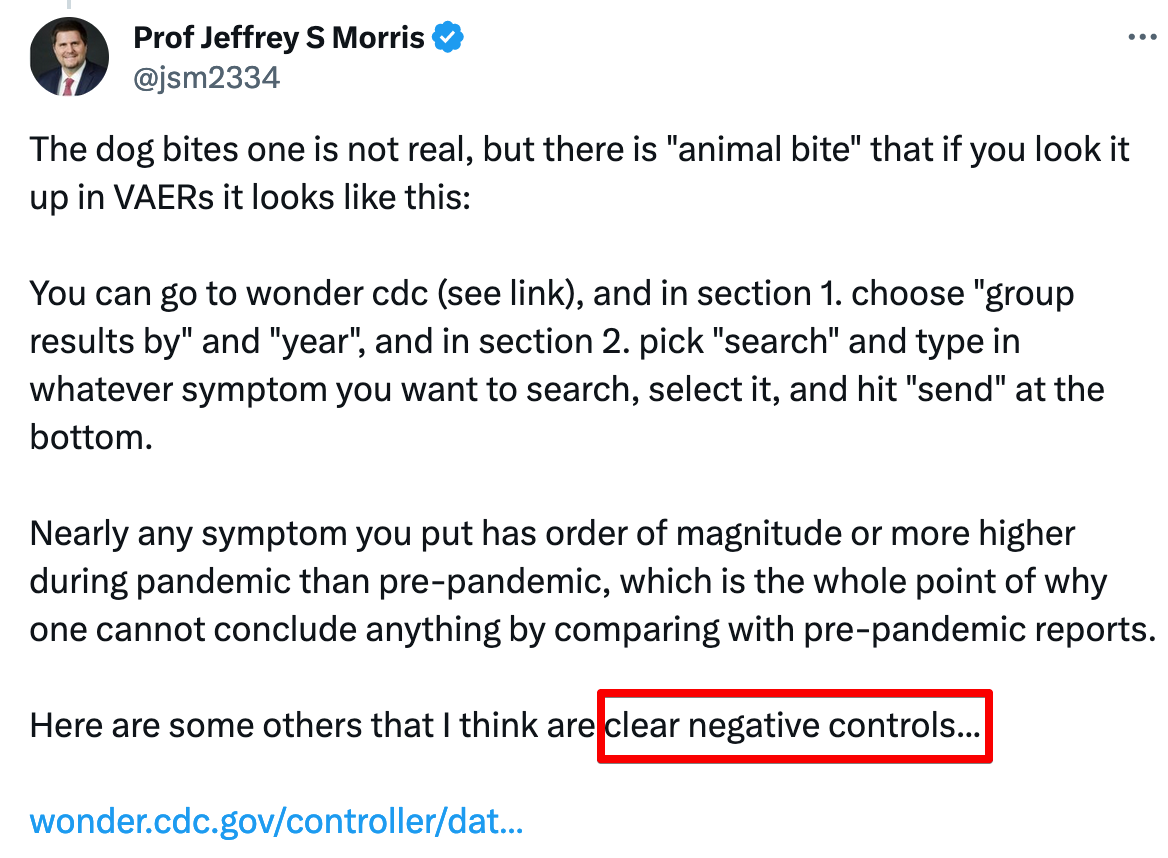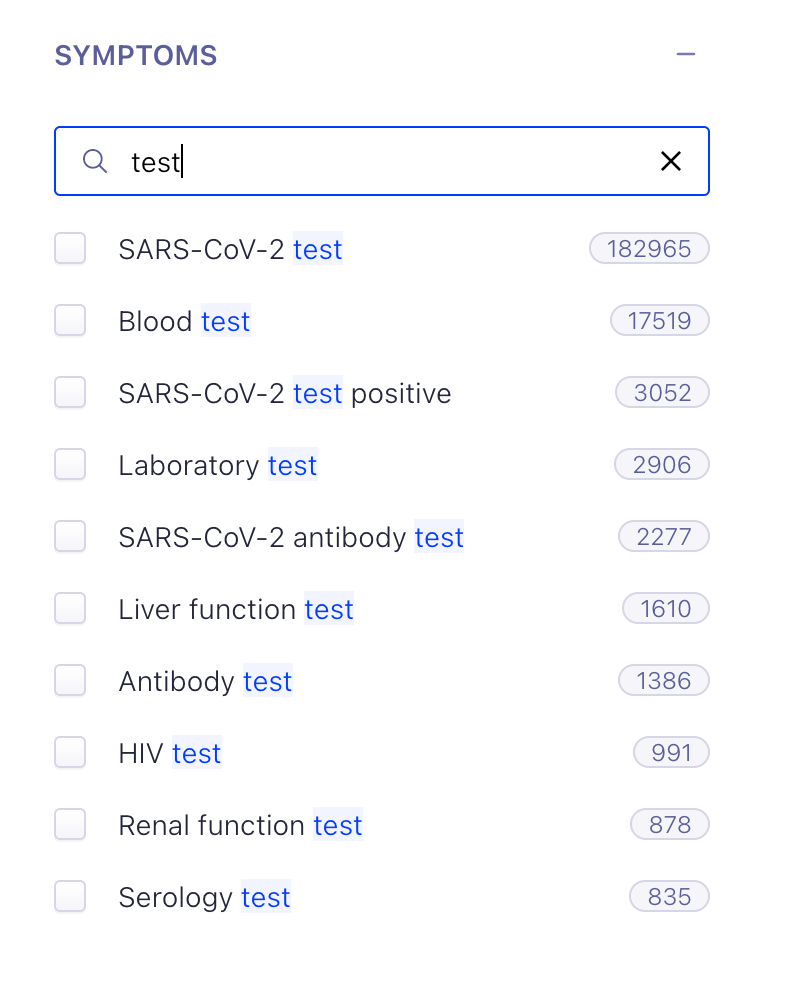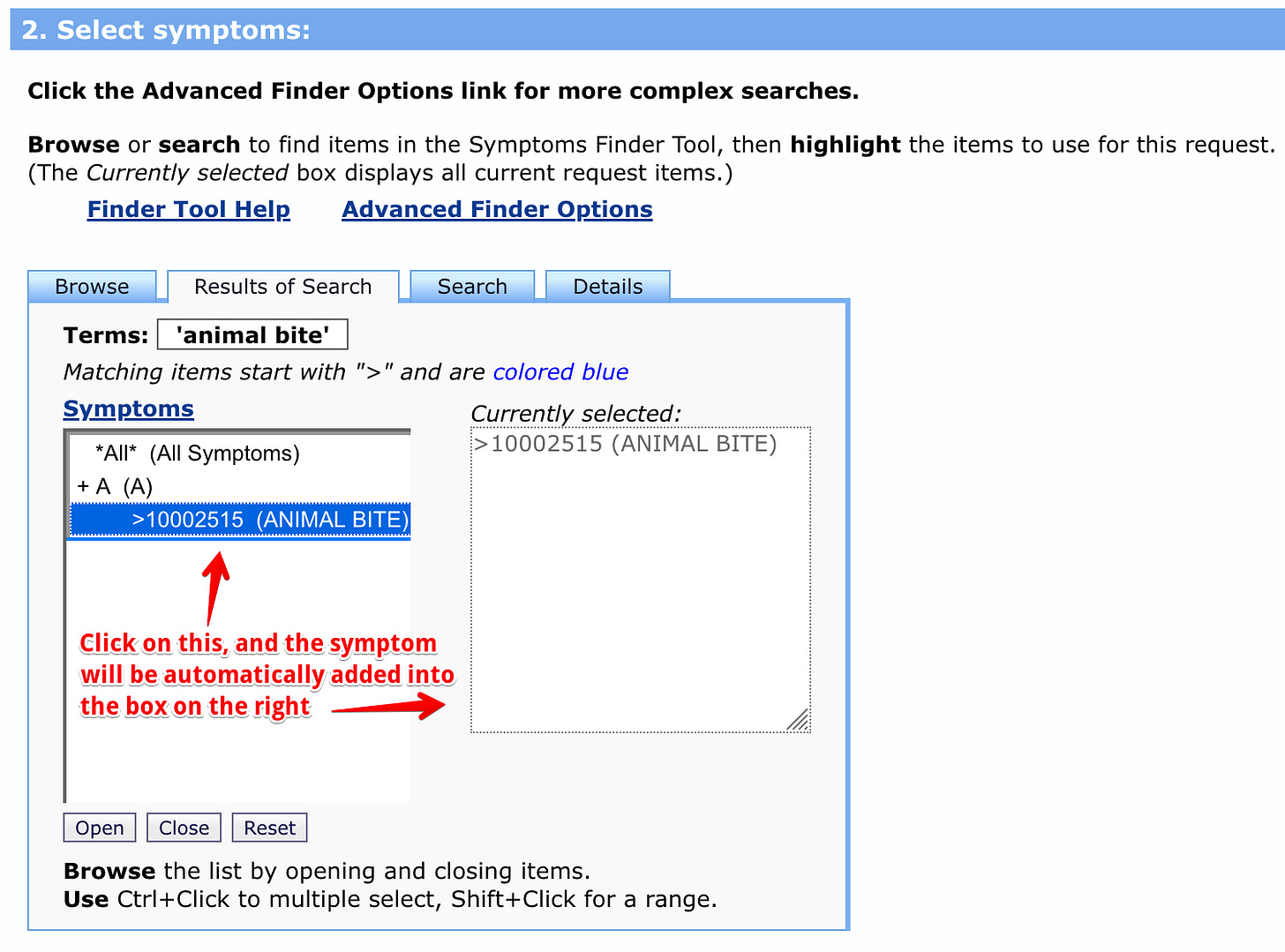Are animal bite VAERS reports "negative controls"?
The vaccine pushers refuse to do even BASIC legwork, and it is looking comical
Summary:
Most reports of Animal Bite are not frivolous. This is clear if you take the time to read through them
There are many examples of non-symptoms being added as symptoms into VAERS (for e.g. various lab tests). I don’t know why they are added as symptoms, but the mere presence of a non-symptom does not invalidate the actual adverse reaction
There are even some logical explanations for the sudden increase - namely, the strict scheduling imposed by a multi-dose vaccine prompting people to file a VAERS report just to record the schedule change if they needed to get another vaccine which is sometimes necessary for animal bites1, and sometimes the animal bite is recorded as a potential event of concern even if all the other symptoms are just regular post-vaccine symptoms
The “Animal Bite” example makes it is very clear that the vaccine pushers refuse to do even basic legwork. Is this just mental laziness, or is this a much bigger structural problem (skillset deficit)?
Recently I saw a tweet from Prof Jeffrey S Morris.
This is the chart he provides for “Animal Bite”
At first glance, this even makes a very compelling case.
Why would anyone report an Animal Bite as a post-vaccine symptom?
Since it has gone up so much, it means all these “clearly frivolous” reports are also proportionally going up because we vaccinated so many people in such a short span of time, right?
But let us take a look at what happens if we dig a little deeper. I downloaded the individual VAERS reports (I explain how to do this as at the end of this article).
Are animal bite reports frivolous?
When Prof Morris says these are “clear negative controls”, I am supposing he thinks they are frivolous i.e. non-serious reports. If there is some other way to define “clear” negative controls, I would like to know what it is.
Here is the dataset for all animal bite reports. I have added a few more pieces of information to make it easier for people to filter and analyze these reports.
When you read the reports, you get a different picture.
Here is an example (emphasis mine)
Initial report received on 19 December 2007 from another manufacturer, no corresponding report number provided. The reporter to this manufacturer had been the patient. A patient (age, gender, and date of birth not provided) had received an injection of rabies vaccine, manufacturer unknown, lot number not provided, on an unspecified date. On an unspecified date during the rabies vaccination series, the patient developed shingles. Additional information corresponding to the event was not provided. Recovery status was not reported. Follow-up information was received from the patient on 25 July 2008. Clinic Progress Notes, which were supplied by the patient, indicated that the 71-year-old female patient presented to the clinic on 08 September 2006 with a chief complaint of animal bite. Slightly less than two weeks prior, the patient had been walking her dogs when the dogs attacked a coyote puppy. The patient broke up the fight and was bitten on her hand by her dogs as well as the coyote. The dogs' rabies shots were up to date. On an unspecified date prior to 08 September 2006, the patient was seen by her physician, who initiated treatment with antibiotics. At that time, however, the patient did not relay the fact that she had been bitten by a coyote. When seen at the clinic on 08 September 2006, the patient denied any numbness, tingling or paresthesia around the bite site on her left hand. She denied any neurological symptoms. There were prior bite marks consistent with the patient's history. There was still a slight amount of erythema surrounding the wounds. The clinic started rabies post exposure prophylaxis. The patient was given rabies immunoglobulin and vaccination series (manufacturers, lot numbers not reported). When again seen at the clinic on 11 September 2006, the patient complained of possible shingles on her right eye. The patient has a chronic problem with dacrocystitis for which she has had bilateral eye surgery and for which she uses sulfacetamide solution when needed. The patient used the sulfacetamide solution for 2-3 days for this event, but stopped because there was no improvement. The patient reported some blurriness but no other visual changes. The patient denied any yellow or green drainage and did not know if she had photophobia. On exam, the patient had moderate edema of the upper lid with mild edema of the lower right eyelid. There was mild erythema of bulbar conjunctiva. It was also reported that on 09 September 2006, the patient began having blisters on her forehead which were painful and sometimes pruritic. The patient also described an itching painful rash on her right frontal scalp and right forehead. Diagnosis was herpes zoster with eye involvement. The patient was given a prescription for acyclovir 100mg (to take one table five times per day for 10 days) and Vicodin 5.500 #15 (to take one tablet every 4-6 hours as needed for pain). The patient was strongly encouraged to allow the clinic to make an appointment with another doctor (specialty not reported) for evaluation, but the patient declined. The patient was provided with the phone number of the physician and was strongly encouraged to make an appointment within 48 hours. The patient was to follow-up with the clinic the following day. A notation, hand-written by the patient, indicated that she recovered, but had slight corneal damage. Outcome was not mentioned in the Clinic Progress Notes. This case has been upgraded to serious based upon this new information received.
The first thing you will notice is that this is anything but a frivolous report. It is certainly not a “negative control”.
While I don’t know why they added “Animal Bite” into the list of symptoms, the report itself points out that the patient developed shingles after taking the Rabies vaccine. I suppose this was added to VAERS to report the Shingles.
I encourage you to go and read more reports.
You will see that when you consider these reports in totality, it is clear most of the reports are not frivolous or “negative controls”.
Are there other “symptoms” in VAERS which are not symptoms at all?
This brings us to another question.
Are there other symptoms in VAERS which do not even qualify as symptoms?
Yes.
In fact, there are many!
You might remember the article I wrote a while back about designing a good search interface for VAERS. In that demo, I used foreign VAERS reports.
How to design a good search interface for VAERS
Summary: I have built a proof-of-concept for a VAERS search interface using Algolia. There is a chance they might pull it down because they don’t like the content, so it is a good idea to try it soon if you want to see it in action :-) Individual search results contain summary info as the title, the MedAlerts URL is the subheading, and the first few sente…
If you go to that Demo and search for the word Test in the symptoms facet, you will find this list:
But these are not symptoms! They are tests which identify some problem.
I am not sure why these have been added as Symptoms into these VAERS reports, but it is pretty clear that you cannot look at the name of a symptom and dismiss the entire report.
What caused the sudden increase?
This brings us to the more important question - what caused a sudden jump in 2021 and 2022?
1 The increase can be explained if the COVID19 vaccine rollout changed VAERS reporting requirements in some way
For example, let us do the following: filter the VAX_LIST with COVID19 and then in the SYMPTOM_LIST, filter for rows which do NOT contain the pipe (|) symbol
These are reports for the COVID19 vaccine, where the only symptom is “Animal Bite”. There are 8 such reports.
And reading through them, you can see that nearly all of them are reporting this to VAERS to mention that a different vaccine had to be administered in the middle of the COVID19 vaccination schedule.
There are also reports with multiple symptoms, but you can filter them by searching for the word “tetanus” in the entity list:
This gives us four more reports to add to the 8 previous reports.
In other words, there are 12 reports (out of a total of 29 reports for the COVID19 vaccine) which are simply providing an update to VAERS to point out that the patient had taken another vaccine which interrupts the COVID19 vaccination schedule.
2 The increase can also be explained if there was an adverse event and the patient was bitten by an animal around the time of vaccine administration
In other words, this is just an example of an increase in adverse events, and it just so happened that an animal bit the patient in temporal proximity. The animal bite is an independent variable which happens more often simply because of an increase in the number of adverse reactions.
As it turns out, you see quite a few reports where people clearly experienced a bonafide adverse reaction, but some animal also bit them around the time of vaccination (emphasis mine):
On July 31 about 49 hours after his second dose around 3pm, patient became very lethargic and started crying. We took his temperature and he had a 104.6. We gave him ibuprofen and put him down for a nap. He slept and when he woke up he had a 102. We gave him Tylenol at that time around 6:45pm. He seemed better and was okay the rest of the evening. Before bed he had a temp of 101 so we gave him ibuprofen. He slept about 13 hours. When he woke up on August 1, he was completely inconsolable. He had a 104.3 temp. He didn't want to eat but I was able to get him to eat a few pretzels. I gave him ibuprofen in the morning when he woke up after eating around 11:30am. He was inconsolable a lot of the day and only wanted to watch TV. He ate a very small lunch. I gave him tylenol at that point. His temp was better at 100. After his nap he was crying and didn't want a snack. We went for a walk outside in his stroller and that seemed to help a little. He did eat some dinner but would cry on and off throughout dinner. After dinner, he took a bath and he seemed okay then and the rest of the evening. Before bed, his temp was normal at 98.7. We gave him ibuprofen at that time. He slept 11 hours overnight and when he woke up on August 2nd, he was fussing but not hysterical. His temp in the morning was 99.1 but he started to feel warmer as the day went on. He had a smaller than normal breakfast and a very small lunch. He was crying on and off during lunch. I took his temp again and around 2:30 it was 102. I gave him ibuprofen around 2:30 and put him down for a nap. Overall, hes been better today (August 2) but is not back to normal. He did get bit by a goat on July 31 around 1:30. When I called my pediatrician, they didn't think his fever was related. They did prescribe him augmentin which he has been taking since August 1st.
In this case, the good faith argument suggests that the people who file the report want to make sure no important information is missed.
The bad faith argument2 suggests that there are explicit instructions to blame “everything and anything except the vaccine”.
But in either case, there isn’t any reason to question whether there was an actual adverse reaction. This means “Animal Bite” should probably not have been added as a symptom.
Mental laziness or skillset deficit?
There are only a grand total of 52 US VAERS reports where Animal Bite has been recorded as a symptom till end of 2022
So there are essentially three possibilities -
a) it is a frivolous report
b) it is not a frivolous report
c) SOMEONE JUST MESSED UP when they added Animal Bite as a symptom
If someone messed up and added “Animal Bite” as a symptom, why are we even discussing it, especially when there are more than 30000 reports with an ENTITY_SCORE over 10?
Quantifying "crazy" VAERS reports
One of my first articles talked about how you can calculate a Machine Learning based “medical jargon” score for the narrative text using spaCy’s biomedical NER models. I refer to this medical jargon score as ENTITY_SCORE in the rest of this article. In my view, you can use this score as a proxy for checking if it is a fake/prank report.
So how do you find out if someone messed up?
Well, you can just go and read the report!
What a brilliant idea!
(And not that hard, if there are only about 50 reports in total).
You can read how Jeffrey Morris created his chart in the tweet at the top of this article.
But all he had to do was group by VAERS ID (instead of year) and he could have gone and read the full list of VAERS reports.
Is it just mental laziness that someone refuses to do something this simple?
I will explain how to get individual reports for the chart provided by Jeffrey Morris.
Go to CDC VAERS Wonder tool.
Group by VAERS ID
Go to Section 2, and click on the Search tab.
Type “animal bite” and click on the Search button right below. Make sure you use that particular Search button and don’t go to any other section.
The page will automatically refresh and show ANIMAL BITE as a Symptom. Click on Animal Bite, and it will automatically be added to the list box on the right.
Scroll all the way down to the bottom, and in Section 12, make sure the “Export Results” checkbox is checked.
Now click on the Send button at the bottom of the form.
Instead of going to a report page, you will see that a text file is being downloaded to your computer.
This is what the text file looks like:
You can look up all the individual VAERS IDs (to see why Animal Bite was added as a Symptom) on a search tool like MedAlerts or OpenVAERS.
But a much better option would be to write some code and turn it into a dataset like the one I have provided earlier, which allows you to read through multiple reports at once and try and understand what is actually going on.
Why don’t the vaccine pushers do this stuff? Is it possible that between them, not one of them has the skillset required to do this kind of analysis?
You might remember an article I wrote a few weeks back, where I pointed out that the “Grand Debunk” of VAERS on the Science Based Medicine website was a good example of grand skillset deficit.
But if they are unwilling or unable to do this simple legwork, how can the vaccine pushers be so confident that they actually know what they are talking about?
In fact, there are over 13K reports on “Inappropriate schedule of product administration” in foreign VAERS reports!
If the medical community does not want people to jump to bad faith arguments, they should also object when the CDC decides to be non-transparent about VAERS data. But they don’t seem to do that nowadays, do they? For example, why are they silent on CDC’s decision to stop publishing VAERS writeups?





















Very astute observation about animal bites, I have routinely seen after hundreds of thousands of medical billings including my own stepfather medical physician that doctors can and do misdiagnose early shingles outbreaks for flea, spider and or bug bites especially the earliest days of a shingles or herpes outbreak.